Q&A with Dvora Meyers, Author of New Release: The End of the Perfect 10
Q&A with Dvora Meyers, Author of New Release: The End of the Perfect 10
On July 5, Dvora Meyers is releasing a new book to the gymnastics world and beyond--a look inside the history of the score that defined our sport for decade

On July 5, Dvora Meyers is releasing a new book to the gymnastics world and beyond--a look inside the history of the score that defined our sport for decades.
Meyers dives into the history of the Perfect 10 with its birth in 1976 by Nadia Comaneci and uncovers its demise while analyzing the changes and progression of the U.S. gymnastics system. As a journalist, history buff, and gymnastics enthusiast, Meyers combines years of research and analysis with a passion for gymnastics and storytelling.
We caught up with Meyers to hear about this exciting release...


Photos by Carla Phillips
Dvora Meyers: At first I didn’t want to write a book on gymnastics. I had just come off of doing coverage in 2012 for Deadspin and Slate and I was feeling very content. Then I was having a conversation with my friend Lindsay Green and we were just chatting about the Olympics.
We realized the 40th anniversary of Nadia is coming up and we don’t have the perfect 10 anymore, and aside from memoirs from gymnasts, there really hasn’t been an in-depth look at the story in a while. She was really enthusiastic about the idea, so I decided to write a proposal.
For me, the 40th anniversary of Nadia was really significant because the sport has changed a lot. A lot of people became aware of the sport 40 years ago and it became associated with very young gymnastics and in many respects, the reputation of the sport hasn’t really shifted in the last 20 years.
If you talk to people in the street, they still think that everyone is 14 years old and everyone is tiny, but in reality the gymnasts are getting older, the girls are more athletic, more muscular than they’ve ever been before. I really felt that we needed to go back to where that narrative started with Nadia and update the story for people who are just coming to the sport now.
What chapter is your favorite?
I really like the NCAA chapter. I think that even though it’s not elite gymnastics and it’s not part of the Olympics, I think in the United States, NCAA gymnastics is such a huge part of the gymnastics world and so frequently ignored.
I really liked talking about the role that the NCAA plays—this very strange role of being sort of parallel to the elite track in the Olympic program but also feeding into it. I do wonder, and I also give an answer to this in the book, but how successful would the United States be without this parallel track if the only thing a girl to aspire to was the world of Olympic team, which is so hard to make because there are so few spots? I feel like NCAA is just a really important part of the gymnastics ecosystem that is often ignored by the mainstream.
I would say that I’m trying to serve two different masters and we’re going to see how that goes. On the one hand, I'm definitely trying to reach more mainstream readers. I really think that gymnastics is an interesting topic and I read a lot of sports journalism because I enjoy it.
I definitely hope that if a book is well written about gymnastics, even if it’s a topic that a lot of people don’t think about that much outside the Olympics, it will reach those people too.
Obviously at the same time I am a gym fan, I am a gym nerd, I am one of you. I think the nitty gritty of the scoring system, I try to present in an accessible way will also be interesting to a lot of gym fans because I didn’t know a lot about the politics and the wheeling and dealing that went into the scoring change, even though I follow the sport really closely. So that was somewhat surprising and I think people would be interested—gymnastics fans would be interested in the way their sport has changed the scoring system.
I think I wanted fans to understand the history of their sport and where it fits in the world. I didn’t want gymnastics to be treated as this sort of separate sport with judging that we don’t understand and very young athletes—it’s treated as though it’s the athletic other.
The second part of it is that I'm a reader, and I was very passionate about gymnastics but I was really terrible at it. So for me, I was trying to almost write the book that I wanted to read, and I hope I pulled that off. I want to read a really interesting book about gymnastics that isn’t focused exclusively on eating disorders or abuse, which is really a lot of the long-form work on gymnastics is kind of looking at its pathology as opposed to treating it as a holistic sport.
I think this code makes more intuitive sense in the fact that a routine that is more difficult will be worth more and the gymnast taking the risk to go for harder skills will be rewarded for it.
Do I think the code is in a perfect place? No, I can definitely speak of a few things that I don’t like, such as connecting skills where you don’t connect from the momentum of one to the other. Those kinds of cheaper connections I don’t like.
I’m kind of happy with it, but I wouldn’t say that I’d give the new scoring system a 10 in execution. I think there’s work to be done.
On the one hand you’re allowing a gymnast to really demonstrate true supremacy. So the current setup allows Simone to show just how far ahead she is of everyone, and on one hand that’s great because you want to see that—you don’t want her to be bunched closer to gymnasts who are really not nearly as good as she is. You want her really show how dominant she is. But on the other hand, it makes the competition less exciting when the winner is something of a foregone conclusion. So in a way the sport is definitely less exciting scoring wise because the 10 caps how far ahead one gymnast could get.
I hope that people who know gymnastics will learn something new at the very least or just see another side to the sport we all love.
Related:
Simone Biles: Golden Girl
Meyers dives into the history of the Perfect 10 with its birth in 1976 by Nadia Comaneci and uncovers its demise while analyzing the changes and progression of the U.S. gymnastics system. As a journalist, history buff, and gymnastics enthusiast, Meyers combines years of research and analysis with a passion for gymnastics and storytelling.
We caught up with Meyers to hear about this exciting release...


Photos by Carla Phillips
FloGymnastics: Why did you decide you wanted to write a book?
Dvora Meyers: At first I didn’t want to write a book on gymnastics. I had just come off of doing coverage in 2012 for Deadspin and Slate and I was feeling very content. Then I was having a conversation with my friend Lindsay Green and we were just chatting about the Olympics.
We realized the 40th anniversary of Nadia is coming up and we don’t have the perfect 10 anymore, and aside from memoirs from gymnasts, there really hasn’t been an in-depth look at the story in a while. She was really enthusiastic about the idea, so I decided to write a proposal.
How did you narrow down to writing about the code?
For me, the 40th anniversary of Nadia was really significant because the sport has changed a lot. A lot of people became aware of the sport 40 years ago and it became associated with very young gymnastics and in many respects, the reputation of the sport hasn’t really shifted in the last 20 years.
If you talk to people in the street, they still think that everyone is 14 years old and everyone is tiny, but in reality the gymnasts are getting older, the girls are more athletic, more muscular than they’ve ever been before. I really felt that we needed to go back to where that narrative started with Nadia and update the story for people who are just coming to the sport now.
What chapter is your favorite?
I really like the NCAA chapter. I think that even though it’s not elite gymnastics and it’s not part of the Olympics, I think in the United States, NCAA gymnastics is such a huge part of the gymnastics world and so frequently ignored.
I really liked talking about the role that the NCAA plays—this very strange role of being sort of parallel to the elite track in the Olympic program but also feeding into it. I do wonder, and I also give an answer to this in the book, but how successful would the United States be without this parallel track if the only thing a girl to aspire to was the world of Olympic team, which is so hard to make because there are so few spots? I feel like NCAA is just a really important part of the gymnastics ecosystem that is often ignored by the mainstream.
Who is your target audience?
I would say that I’m trying to serve two different masters and we’re going to see how that goes. On the one hand, I'm definitely trying to reach more mainstream readers. I really think that gymnastics is an interesting topic and I read a lot of sports journalism because I enjoy it.
I definitely hope that if a book is well written about gymnastics, even if it’s a topic that a lot of people don’t think about that much outside the Olympics, it will reach those people too.
Obviously at the same time I am a gym fan, I am a gym nerd, I am one of you. I think the nitty gritty of the scoring system, I try to present in an accessible way will also be interesting to a lot of gym fans because I didn’t know a lot about the politics and the wheeling and dealing that went into the scoring change, even though I follow the sport really closely. So that was somewhat surprising and I think people would be interested—gymnastics fans would be interested in the way their sport has changed the scoring system.
What is the main goal of the book?
I think I wanted fans to understand the history of their sport and where it fits in the world. I didn’t want gymnastics to be treated as this sort of separate sport with judging that we don’t understand and very young athletes—it’s treated as though it’s the athletic other.
The second part of it is that I'm a reader, and I was very passionate about gymnastics but I was really terrible at it. So for me, I was trying to almost write the book that I wanted to read, and I hope I pulled that off. I want to read a really interesting book about gymnastics that isn’t focused exclusively on eating disorders or abuse, which is really a lot of the long-form work on gymnastics is kind of looking at its pathology as opposed to treating it as a holistic sport.
Do you think the Code is in a good place right now?
I think this code makes more intuitive sense in the fact that a routine that is more difficult will be worth more and the gymnast taking the risk to go for harder skills will be rewarded for it.
Do I think the code is in a perfect place? No, I can definitely speak of a few things that I don’t like, such as connecting skills where you don’t connect from the momentum of one to the other. Those kinds of cheaper connections I don’t like.
I’m kind of happy with it, but I wouldn’t say that I’d give the new scoring system a 10 in execution. I think there’s work to be done.
Do you think it separates the top gymnasts too much?
On the one hand you’re allowing a gymnast to really demonstrate true supremacy. So the current setup allows Simone to show just how far ahead she is of everyone, and on one hand that’s great because you want to see that—you don’t want her to be bunched closer to gymnasts who are really not nearly as good as she is. You want her really show how dominant she is. But on the other hand, it makes the competition less exciting when the winner is something of a foregone conclusion. So in a way the sport is definitely less exciting scoring wise because the 10 caps how far ahead one gymnast could get.
Anything else you’d like to include about the book and its release?
I hope that people who know gymnastics will learn something new at the very least or just see another side to the sport we all love.
Related:
Simone Biles: Golden Girl